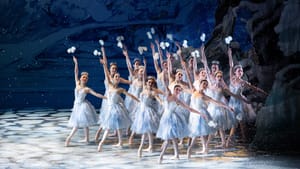Stay in the Loop
BSR publishes on a weekly schedule, with an email newsletter every Wednesday and Thursday morning. There’s no paywall, and subscribing is always free.
The corps de ballet, breathing as one
Philadelphia Ballet presents George Balanchine’s The Nutcracker

The Nutcracker is chock full of gasp-worthy moments that stay with us forever. Audiences wait for the great tree to rise to its full height and recognize the first notes of the celesta for the dance of the Sugar Plum Fairy. But it is the corps, almost flying across the stage in the “Waltz of the Snowflakes,” that takes our breath away, and the “Waltz of the Flowers” that steals our hearts. When we spoke last year, artistic director Angel Corella reminded me that “The Nutcracker is not possible if not for the corps de ballet. They are the ones that work the hardest, doing Snow and Flowers every night.”
Collective discipline
For Corella, seeing the corps develop over the past few years has been a pleasure. As he explained, the staff did a lot of work with the dancers, “but if they didn’t understand how to be connected, then it wouldn’t have happened.”
When I sat down on Zoom with three of the corps dancers—demi-soloist Lucia Erickson and apprentices Paloma Berjano Torrado and Emily Wilson—to talk about what it takes to be a Nutcracker dancer, they echoed Corella’s sentiment. Experience helps, and they have performed the Nutcracker before. Erickson explained that “it’s in our body, and we are not relearning the steps every year.” But the key is to be selfless, and that takes work: “We have to care that everyone looks good together ... just making sure that everyone’s head is tilted the same way, and everyone is breathing at the same time.”
For Torrado, it is about the discipline to keep in the formations, and for Wilson, it is about the mindset, which is “completely different to how you would feel dancing by yourself. Sometimes rehearsing can get really difficult, because it’s slow and a little painstaking. You kind of have to go outside of yourself a little bit to put it all together." Erickson agreed: “I think you feel more accomplished dancing as a group sometimes because you know that other people are depending on you.”
Snow or Flowers?
Members of the corps may each dance up to three parts in a performance, and those parts will vary from night to night. You will see them as maids and grandmas and Columbine dolls, as marzipan and dewdrops and hot chocolate. But the success of the Nutcracker rests on the toes of the Snowflakes and Flowers, so I had to ask which of the two big Waltzes was the dancers’ favorite.
Wilson answered first: “I think my favorite is Snow, but we’ve had this discussion as the corps de ballet before.” I could tell from the laughter it is an old and ongoing debate. For Wilson, the “Waltz of the Snowflakes” transcends the ballet. "It’s like its own little thing, and you feel so accomplished to finish the first act, and you see the curtain go down.” It’s Torrado’s favorite as well. The dancers all love the moment when the snow begins to fall, tiny pieces of paper that they find everywhere, even in their apartments weeks later. “Sometimes you can swallow them,” Torrado said. Her favorite moment is when the chorus joins the music: “when the children start singing, you are in another world.” She called it a magical moment, and I had to agree.
The “Waltz of the Snowflakes” creates an otherworldly transition from the more familiar party scene to the fairyland of candy we will enter in the second act, and it is the most difficult of the ballet’s corps dances. In fact, music director Beatrice Jona Affron described it as “a fiendishly difficult dance, and long. It taxes the endurance of the women of the corps.” It’s rhythmically complex, with many variations and, as the dancers pointed out, it brings the Balanchine energy—the movement feels freer than in a traditional corps ballet like Giselle or Swan Lake, but it is fast and complicated.
Snowflakes gives the individual dancers of the corps a chance to shine, something that Torrado enjoys. “In Snow, we each have our own moment at the beginning. That never happens in traditional ballet,” and for Wilson, “It’s a little more showy at times, and there are moments when you break apart and get a chance to show your own dancing.” Of course, it is Balanchine, so there is also a mad scramble for snowflakes, the props on wands for the full corps part of the dance. Wilson described the entrance as “just shot out of a cannon. There is no time to think or to breathe or anything.” And there is nothing to hide behind, no soloist to pull the attention. So it has to be perfect.
Flowers breathing together
For Erickson, it is a hard choice, but “Waltz of the Flowers” wins as her favorite: “I love the music.” It has, music director Affron had reminded me, that wonderful tune, but it is another long, taxing, precise piece: “you can see every arm, every wrist; [Balanchine] made it so clear.” It’s that precise unison that appeals to Erickson: “In Flowers, I have a lot of fun because I can connect with the other corps members. Like the breathing in Flowers, we’ll do a port de bras forward and back, and everyone will let out this breath together. Honestly, a little bit too loud, we shouldn’t be doing that, but it just feels good.” (We in the audience find ourselves breathing along, so it works out fine!) At the same time, she finds the dancing freer: “It is a little more dance-y to me, and I can let go a little more.”
Like all ballerinas, they have their dream roles—for Torrado, it is Kitri, in Don Quixote because she loves the style, and for Wilson, it is Juliet in Romeo and Juliet, because she loves the music. But Erickson loves the Sugar Plum Fairy. “The music for the pas de deux is my favorite music ever,” she said, “And I just think the pas is so beautiful.” But they had to admit that being onstage and breathing in time with all the other dancers is, “hands down, the best” feeling.
What, When, Where
The Nutcracker. $25-$225. Choreography by George Balanchine. Philadelphia Ballet, presented by the Academy of Music. December 10-31, at the Academy of Music, 240 South Broad Street, Philadelphia. (215) 893-1999 or philadelphiaballet.org.
All patrons must wear masks inside the building. Patrons aged 12 and over must show proof of full Covid-19 vaccination at entry. (Patrons over 18 must also show photo ID.) Proof of negative Covid tests will not be accepted, with the exception of children under 12, who are required to show either proof of vaccination or a negative PCR test taken within 72 hours before showtime.
Accessibility
The Academy of Music has wheelchair seating available, as well as seating locations near the stage for patrons with low vision or blindness. Audio description and ASL interpretation are available for select performances. The 12pm matinee on Monday, December 27, 2021, is a sensory-friendly performance.
Sign up for our newsletter
All of the week's new articles, all in one place. Sign up for the free weekly BSR newsletters, and don't miss a conversation.

 Camille Bacon-Smith
Camille Bacon-Smith